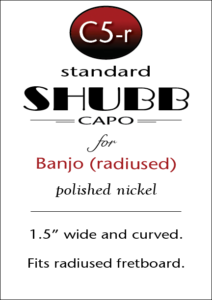 For instruments with radiused fretboards.
For instruments with radiused fretboards.
Most banjo, mandolin, or bouzouki fretboards do NOT have a radius. If you’re not sure, chances are that yours is flat.
When the Shubb capo was first introduced more than 30 years ago guitarists throughout the world fell in love with it. They’re still in love with it today. We’ve given it a few tweaks through the years, but its basic mechanical principle remains the same: a unique over-center locking mechanism that provides an unrivaled combination of power, speed, accuracy and ease of use. One smooth flip of the lever locks it securely in place, and removes it just as quickly.
And the Shubb capo is BY FAR the best at not creating tuning problems. Its soft, resilient rubber is specially designed to work just like a fingertip, so it doesn’t bend the strings over the frets. Its closing action is just like your hand, so it doesn’t pull the string off center. As a result, no re-tuning is necessary!
In 2013 our standard line of capos received its biggest tweak yet: we’ve upgraded our most popular models – the “C” series nickel plated capos – to include the design features formerly available only on our deluxe, stainless steel models.
When we say that the roller provides superior geometry, we really mean it. Beyond the advantages that are immediately apparent, read more about this…
Capos continue to come and go, but the fact remains for the guitarist who is serious about quality and intonation…nothing but a Shubb will do.
Model 5 — “for Banjo, also fits most mandolins and bouzoukis” — covers four strings, or string pairs. On a 5-string banjo, the 5th string is dealt with separately, either with spike installed in the fretboard, or with our own 5th string capo. The model 5 is also a good fit on various other 4-string instruments, including tenor guitar and ukulele, although we do have models specifically for uke (L9 and C9b). The model 5 has been used famously by Andy McKee as a partial capo, covering four strings of his guitar, on his tune Rylynn.
